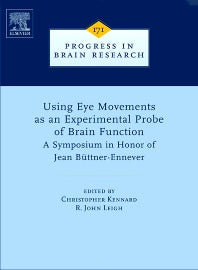Freshly Printed - allow 10 days lead
Couldn't load pickup availability
Using Eye Movements as an Experimental Probe of Brain Function
A Symposium in Honor of Jean Büttner-Ennever
This is a volume in the Progress in Brain Research serial, providing a comprehensive overview over the research in the study of eye movements. To the neurobiologist, the study of the control of eye movements provides a unique opportunity to understand the workings of the brain; to neurologists and ophthalmologists, abnormalities of ocular motility are frequently the clue to the localization of a disease process. Moreover, the visual and perceptual consequences of eye movements are important to both basic scientists and clinicians.
R. John Leigh (Edited by), Christopher Kennard (Edited by)
9780444531636, Elsevier Science
Hardback, published 2 September 2008
652 pages
26.2 x 19.2 x 3.5 cm, 1.68 kg
This volume of Progress in Brain Research is based on the proceedings of a conference, "Using Eye Movements as an Experimental Probe of Brain Function," held at the Charing Cross Hospital Campus of Imperial College London, UK on 5th -6th December, 2007 to honor Professor Jean Büttner-Ennever. With 87 contributions from international experts – both basic scientists and clinicians – the volume provides many examples of how eye movements can be used to address a broad range of research questions. Section 1 focuses on extraocular muscle, highlighting new concepts of proprioceptive control that involve even the cerebral cortex. Section 2 comprises structural, physiological, pharmacological, and computational aspects of brainstem mechanisms, and illustrates implications for disorders as diverse as opsoclonus, and congenital scoliosis with gaze palsy. Section 3 addresses how the cerebellum transforms neural signals into motor commands, and how disease of such mechanisms may lead to ataxia and disorders such as oculopalatal tremor. Section 4 deals with sensory-motor processing of visual, vestibular, somatosensory, and auditory inputs, such as are required for navigation, and gait. Section 5 illustrates how eye movements, used in conjunction with single-unit electrophysiology, functional imaging, transcranial magnetic stimulation, and lesion studies have illuminated cognitive processes, including memory, prediction, and even free will. Section 6 includes 18 papers dealing with disorders ranging from congenital to acquired forms of nystagmus, genetic and degenerative neurological disorders, and treatments for nystagmus and motion sickness.
Section 1: Using Novel Techniques to Define the Neural Substrate for Eye Movements
Jean Büttner-Ennever, Munich: Re-mapping the oculomotor system
Joseph Demer, Los Angeles: Using high-definition MRI to re-define the mechanics of eye rotations
Michael Goldberg, New York: The cortical representation of oculomotor proprioception
David Zee, Baltimore: How new knowledge of the anatomy of the eye muscles and their innervation translates into improved treatment of patients with ocular motor palsies
Paul Knox, Liverpool: Testing the influences of extraocular proprioception in humans
James Sharpe, Toronto: Reinterpreting palsies of the ocular motor nerves
Dominik Straumann: New insights into trochlear nerve palsy
Paul May: Anatomical insights into peripheral gaze control
Louis Dell'Osso: How disrupting ocular proprioception can be therapy for congenital nsyatgmus
Section 2: New Insights into Brainstem Generation of Ocular Motor Commands
Anja Horn, Munich: New insights into the circuitry and pharmacology of the brainstem reticular formation
Edward Keller, San Francisco: Using multiple electrode arrays to map moving fields of neural activity in the superior colliculus
Paul Gamlin, Birmingham: Synthesis of vergence control by brainstem circuits
Holger Rambold, Lübeck: Disturbances of vergence and saccadic eye movements by human brainstem lesions
Christoph Helmchen, Luebeck: Understanding how the cerebellar disease could cause saccadic oscillations
Stefano Ramat, Pavia: A brainstem network that accounts for abnormal saccades
Mark Gibson, Belfast: Human saccadic disorders and their brainstem mechanisms
Richard Clement: A black-box approach to saccadic disorders
Section 3: Using Eye Movements as an Index of Transformation of Signals by the Cerebellum
Stephen Highstein, St. Louis: How the cerebellar transforms sensory inputs into motor commands
Albert Fuchs, Seattle: How visual and motor signals interact in the cerebellum
John Stahl, Cleveland: How mutant mice with calcium channel defects provide insight into the cerebellar role in balance
Michael Strupp, Munich: How knowledge about calcium channel disorders translates into treatment of human cerebellar disease
Bernard Cohen, New York: Cerebellar governance of vestibular mechanisms
Mark Walker, Baltimore: Influence of cerebellar nodulus on translational vestibulo-ocular reflex
Ulrich Büttner, Munich: Control of smooth-pursuit eye movements by cerebellum
Robert McCrea, Chicago: Influence of cerebellum on combined eye-head tracking
Adolfo Bronstein, London: Degenerative disorders that affect the cerebellar control of eye movements
Section 3: Using Eye Movements as a Probe of Sensory-Motor Processing
Frederick Miles, Bethesda: How the brain uses visual motion as we move through the environment
Peter Hoffmann: How motion signals are encoded in visual areas
Michael Mustari, Atlanta: How disturbed maturation of visual motion processing leads to nystagmus in infancy
Thomas Brandt: How vestibular and visual inputs may be abnormally processed in cerebral cortex
Richard Abadi, Manchester: Visual perceptions during ocular oscillations
Michael Gresty, London: Self-motion, gaze control and visual perception
Bernhard Hess, Zurich: Understanding interactions between responses to head rotations and translations
Michael Halmagyi, Sydney: Probing otolith-ocular reflexes using novel stimuli in humans
Sergei Yakushin, New York: How visual inputs from subcortical pathways influence perception of self-motion
Section 4: Using Eye Movements as a Probe of Cognition
James Lynch, Jackson: Concepts of the contribution of cerebral cortex based on new anatomical findings
Kikuro Fukushima, Sapporo: Prediction, eye movements, and the frontal lobes
Rene Müri, Bern: Using transcranial magnetic stimulation to probe decision-making and memory
Parashkev Nachev, London: Using functional imaging to during conflict resolution and free choice
Charles Pierrot-Deseilligny, Paris: Using saccades to probe different forms of memory
Christopher Kennard, London: Role of the supplementary eye fields in countermanding saccades
Masud Husain, London: Using eye movements to probe shifts of instruction set
Graham Barnes, Manchester: Using smooth tracking movements to probe prediction
R. John Leigh, Cleveland, Ohio: Eye movements: The meaning of it all (Epilogue)
Subject Areas: Neurosciences [PSAN], Neurology & clinical neurophysiology [MJN], Physiology [MFG], Physiological & neuro-psychology, biopsychology [JMM]


